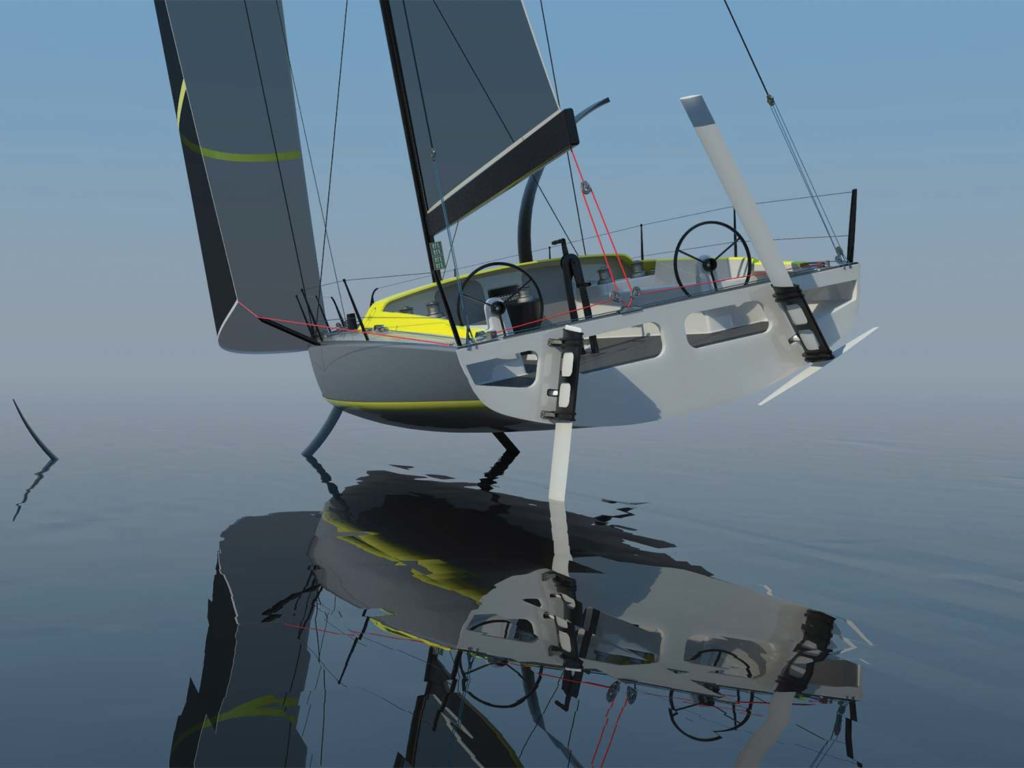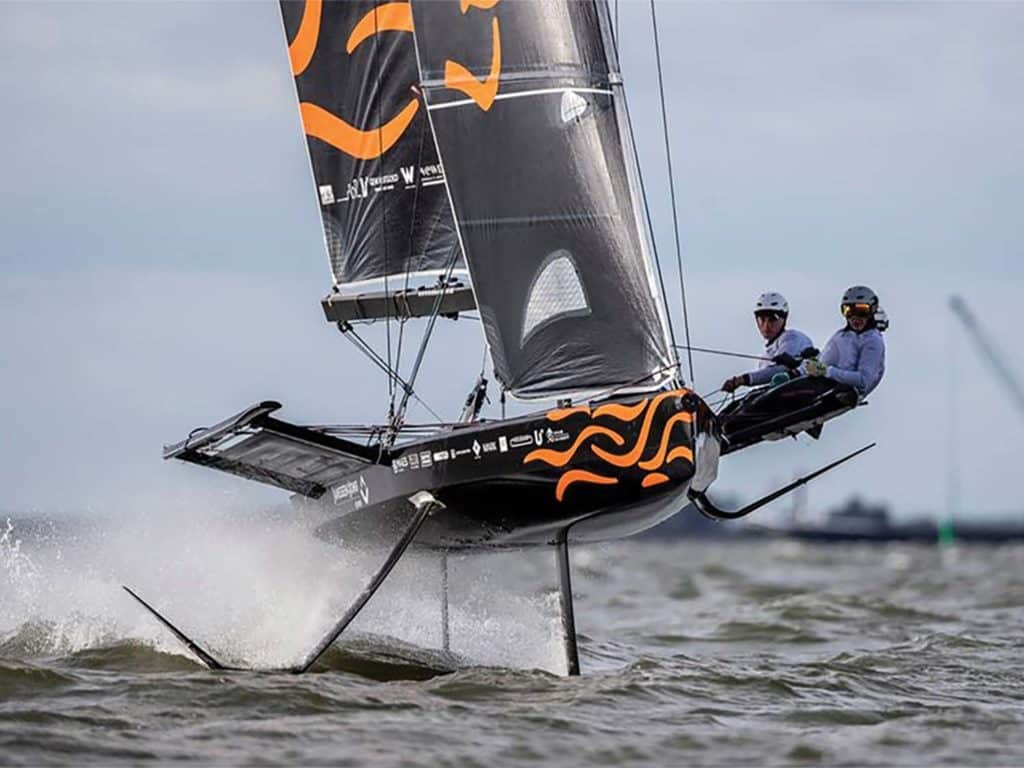
Nicolas Henard, president of the French Sailing Federation, was charged by the Paris 2024 committee to be bold and brave in his promotion of new Olympic sailing events. Like the dramatic gold-medal design of Marianne—the female symbol of the French Republic blended into the Olympic flame—the slate of events Henard and his colleagues at World Sailing voted in for 2024 is bold indeed. Nearly half of the sailing events will showcase hydrofoils. I witnessed that 2018 vote, and there were many arguments for and against moving so swiftly toward the future of foiling in the Olympics, but the door was thrust wide open, accelerating the inevitable evolution in high-performance sailing we are experiencing today.
Predictions that “everything will have foils” in the future, however, have yet to materialize. What’s missing? Big boats. Yes, the Ocean Race now has foiling IMOCA 60s, as does the Vendée Globe. Mini Transat designs are flying. The 75-footers of the America’s Cup are developing by the day. But no one has been daring enough to build a big monohull sailboat with foils, save for a few of the horizontal DSS foil systems.
The benefits to either fully flying or foil-assisted sailing are known: more righting moment, higher speeds, less heel angle, maybe a more comfortable ride. But the prohibitive barriers are also known: Rating rules are not ready to interpret the dramatic speed deltas between foiling and displacement modes; large foilers would be far more expensive for their size and scale than a similar-size displacement monohull; and without any larger monohull foilers, foil-assisted cruising boats, ocean racers or superyachts on the market, few owners with the financial wherewithal have been willing to take the leap and be first.
Luckily, all the latent interest in foiling is finally showing up in big monohull projects. And who are the brave designers feeding this interest? The venerable Frers family is in the mix, and there are a few others behind closed doors who are secretly poised to turn renderings into realities. But is the rest of the sailing world going to follow these designers into the future? Will foils become a regular fixture at race weeks and offshore races, just as foiling dinghies and boards are now globally prolific?
“We’re applying foils to the casual sailor to achieve the same speeds as a motorboat,” says Mani Frers, the third-generation yacht designer whose father, German, drew some of the most iconic racing and cruising boats of the past 40 years. “Clients are asking for speed, not necessarily foiling.”
Frers hasn’t seen his first foiling concept come to fruition—yet. But he’s getting close. His response to the application of hydrofoils has been predictably intense and unique, altogether avoiding the tantalizing desire to make a large yacht fly above the water. “One of the issues with foiling as a new thing is that no one applies science,” he says. “There are a lot of good things and a lot of BS. I apply foil technology to the whole package.”
Frers, whose son, German Frers VI, is fully involved in their Milan design house, is in the closing stages of two foiling designs: a 60-foot daysailer and a superyacht. He concedes that using foil assist to achieve higher speeds and a stable ride isn’t sexy compared with flying. But the end result of a steady 20 to 25 knots of boatspeed in 12 to 15 knots of wind is attractive.
“We want to bring these boats up to 20 knots and have them just sit there,” Frers says. “Then we start to depower. We use only two sails. It’s like free-ride windsurfing. People don’t want to wear helmets.”

Frers won’t yet reveal the designs he is running through the same simulators used by America’s Cup teams. Why can’t he describe the application of the hydrofoil? Is it sticking out the bottom? The side? Are there two, four or one? He can’t share what’s up his sleeve because it’s early days, and his clients don’t want to see their innovations appearing on other boats before theirs is created.
Regardless of the foil configurations, Frers says his superyacht design is fast enough to generate its own energy—an ancillary benefit of the foils. A hybrid propulsion system “harvests energy while sailing,” he says. “The big-boat foils kick in at 10 knots true windspeed. When under sail, it generates its own power. Foils create more energy. That technology is helping us create a new generation of yachts.”
Frers is blissfully free of rating-rule constraints with these two designs. But it is still surprising that rating rules—or the fear of not rating well if the owner does decide to race— is still driving demand for monohull designs. This is one reason why there aren’t any foilers being built and sailed by the average big-boat owner in major ocean races. But there are quite a few new foilers further down the size range.
Designers Laureano Marquinez and Nahuel Wilson, for example, were tired of waiting for a client to commission a fully foiling big boat, so they designed one themselves. With interest from clients in South America, New Zealand and Italy, the Argentinians tackled a 40-foot ocean-racing foiler called the MW40OF. The boat is lightweight, with large circular daggerboards similar to those of Alex Thomson’s IMOCA 60 Hugo Boss, as well as twin T-foil retractable rudders. It sure looks like the future of ocean racing, especially for amateur ocean-racing sailors who don’t mind spending their off watch bouncing around in their bunk with one eye open.
“We wanted to bring a fully foiling boat as simple and manageable as we could think of,” says Marquinez, who designed the midrange foiling Persico 69F that’s being used for the Liberty Bitcoin Youth Foiling World Cup. The MW40OF is currently a “very well-advanced preliminary project,” he says.
The MW40OF is expected to double the speed of a modern custom 40-foot displacement monohull. “If the boat is not fully foiling,” Wilson says, “the VMG is a little better, lower and faster.” He adds that the boat can find modes upwind to fully foil but that skimming at a wider angle is more likely the faster technique.
Yes, this is going to be a super-slippery boat. Even the renderings show No. 40 ripping through a gray, windswept sea and a menacing sky reminiscent of a Fastnet Race, foretelling its potential. Wilson says this is a movement in ocean sailing that can open doors for younger sailors with high-performance foiling skills. Steering, and even standing, on a 40-footer flying at 25 to 30 knots would be an acquired skill, and young foilers have that in spades, along with the ability to steer precisely when things are coming at them fast.
Before we see these influences, however, there first has to be a boat. To make a dent in the ocean-racing fleet, the boat must have a competitive rating. Being the first to tackle this design equation in the common size of big boats means taking the rating rules themselves head-on.
“This is a very early step in rating these boats,” Marquinez says. “In some senses, once you’re flying, the drag and forces of the appendages are easier to predict. But the transition is tricky.”
For Frers, the value proposition of foils is simple: They add speed and comfort. The attractiveness of the MW40OF is something more complicated. “It’s a new experience,” Wilson says. He draws his inspiration for the design from his Persico 69F, which sails with similar appendages and has a daggerboard instead of a keel. “A new program like this will bring a new dimension to club teams. Speed is really addictive.”
Speed is one thing. Foilers have that. But for the vast majority of ocean sailors, crews and owners, boatspeed is just one part of the equation. A lot has to fall in place for foiling to gain acceptance at traditional keelboat regattas, and through their designs, Frers, Marquinez, Wilson and others have a lot of questions to answer. If not bullish at the moment, they are incredibly upbeat.
“We hope to see more foilers, but it’s not super-easy to put one of these together,” Marquinez says. “It’s natural to see where performance sailing goes, but we don’t know where it ends. We do know that these steps we are taking now must be taken.”
Let’s not fool ourselves. The success of foiling big boats has everything to do with those who write the checks. And compromise in design will show the benefits of foils as a contributing solution rather than the main event. Not sexy, but better.
“The future depends on the client,” young German Frers says. “There’s not one route. The newer generation likes foiling, and others don’t think it’s real sailing. This type of foiling is letting more conservative people like foiling. It’s merging two concepts into one.”









